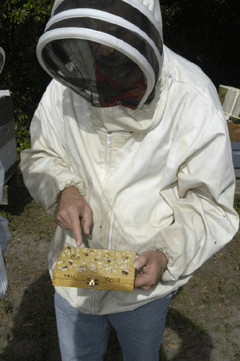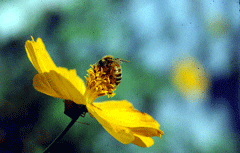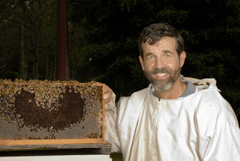Bees On Their Knees
Air Date: Week of March 2, 2007

Jerry Hayes counts the number of varroa mites (dark spots visible against white drone bees) on drone brood (young bees) pulled from a colony. (Courtesy of Florida Department of Agriculture and Consumer Services)
A mysterious ailment is killing the nation's honeybees, and it’s spreading over nearly half the United States. Steve Curwood talks with Jerry Hayes, chief of the Apiary Section of Florida's Department of Agriculture.
Transcript
CURWOOD: It’s Living on Earth. I’m Steve Curwood. Something mysterious is killing the nation’s honeybees and it’s alarming scientists and beekeepers, who first noticed the strange die-off last year. Now the bizarre syndrome, which researchers have dubbed “Colony Collapse Disorder” has spread to nearly half the states and is responsible for killing as many as 90 percent of the hives in some places.
And there have been similar reports from Europe as well. The rapid die-offs here put more than a third of U.S. food crops in peril because without honeybees, many fruits, vegetables, and nut trees wouldn’t get pollinated. Jerry Hayes is Chief of the Apiary Section at Florida’s Department of Agriculture. We gave him a buzz on his cell phone in a research field outside of Gainesville.
Hi there Jerry—
HAYES: How are you doing Steve?
CURWOOD: Hey uh I think I can hear some bees. Are you wearing your protective hood and uniform now?
HAYES: Yes, if you could see me right now I, ah, have a white jacket on and a veil and there are thousands of bees in the air. Let me walk over here to one of the colonies and maybe you can even hear better.

A honey bee. (Courtesy of USDA)
HAYES: Uh yes. Actually the first reported case to me was late last summer in Florida. And it’s just gotten, ah, more confusing and frustrating as the months have gone by.
CURWOOD: So, the mystery then continues. Um, if you could please, ah, describe the disorder for me. What do the bees look like when they die?
HAYES: Well that’s the problem the bees are leaving the colonies. They’re not coming back. They’re actually disappearing as if the adult workers, the foragers, are going out and not remembering how to get home. So there aren’t any dead bodies as you would see in a pesticide kill or something. The hives basically dwindle over time as bees leave the colony and, ah, don’t return which is very unusual for a social insect like the honeybee because they are very colony oriented. They want to take care of the brood, the queen, so to leave the colony and not come back is highly unusual.

Jerry Hayes counts the number of varroa mites (dark spots visible against white drone bees) on drone brood (young bees) pulled from a colony. (Courtesy of Florida Department of Agriculture and Consumer Services)
HAYES: Yes, and all these are normal organisms that are associated with honeybee colonies. But the honey bee’s immune system seems to be being compromised and allowing these what would be normal organisms in the honey bees to proliferate and may be causing some of the final death stages.
CURWOOD: There’s some suggestions that it could be due to some chemicals that are used on plants. And these chemicals, in fact, have been banned in Europe. What are you finding?
HAYES: Um you know the ultimate answer on that is still out. But yes you’re right Steve there is a class of insecticides called neonicotinoids, of which, ah, an active ingredient called imidacloprid has been banned in some countries in Europe because of its association with damaging, ah, pollinators. It has a tendency to, at least in the European data, to have the bees forget how to get home. And so this is one of the components that we’re seeing here. And these neonicotinoids and imidacloprid is used pervasively in agriculture in the U.S. Primarily it’s a systemic. So it does what it’s supposed to do on harmful agricultural pests but it’s working its way through the plant up into the flowers and getting into the nectar. Ah, in doses that will not kill a honeybee out right. So the question is what are the chronic long-term 24/7 365 exposures doing to the honeybees and is this a component of the problem?

Jerry Hayes examines honey comb for pests and diseases. (Courtesy of Florida Department of Agriculture and Consumer Services)
HAYES: Well, yeah and if you look at the literature this imidacloprid is used on another social insect; the termite. Termites are social insects just like the honey bees and they have a very organized nesting colony. The imidacloprid used in termite colonies causes death by a couple of different means. One of them is that the termites go out to feed and they can’t remember how to get home. And it causes them to be susceptible to, ah, natural organisms in their own nest colony. So if you extrapolate to honey bees, you know, this is kind of a scary thing.
CURWOOD: People eat a modest amount of honey but they seem to be crucial to agriculture. Can you explain?
HAYES: Yes, we think of honey bees as producing honey. And honey is a wonderful food. It comes in great varieties and is wonderful, but it’s a byproduct of pollination. Without honeybees and other pollinators to take pollen from one flower to another flower to fertilize the seed, the plant then has no inclination to build a fruit then around that seed. So if you don’t have honey bees about a third of the food you and I eat every day would disappear. And Albert Einstein, a guy a lot smarter than I am, said that if honey bees became extinct, human society would follow in four years. We’re all connected here. And so one of my questions is, are honeybees the canary in the coalmine here? Are they exhibiting things because of agricultural and environmental toxins that we should be paying more attention to as humans?
CURWOOD: Jerry Hayes is chief of the apiary section with Florida’s Department of Agriculture. Thank you sir.
HAYES: Thank you Steve. And I appreciate the opportunity to tell you how important honey bees are.
Links
Mid-Atlantic Apiculture: Colony Collapse Disorder Working Group
Living on Earth wants to hear from you!
Living on Earth
62 Calef Highway, Suite 212
Lee, NH 03861
Telephone: 617-287-4121
E-mail: comments@loe.org
Newsletter [Click here]
Donate to Living on Earth!
Living on Earth is an independent media program and relies entirely on contributions from listeners and institutions supporting public service. Please donate now to preserve an independent environmental voice.
NewsletterLiving on Earth offers a weekly delivery of the show's rundown to your mailbox. Sign up for our newsletter today!
 Sailors For The Sea: Be the change you want to sea.
Sailors For The Sea: Be the change you want to sea.
 The Grantham Foundation for the Protection of the Environment: Committed to protecting and improving the health of the global environment.
The Grantham Foundation for the Protection of the Environment: Committed to protecting and improving the health of the global environment.
 Contribute to Living on Earth and receive, as our gift to you, an archival print of one of Mark Seth Lender's extraordinary wildlife photographs. Follow the link to see Mark's current collection of photographs.
Contribute to Living on Earth and receive, as our gift to you, an archival print of one of Mark Seth Lender's extraordinary wildlife photographs. Follow the link to see Mark's current collection of photographs.
 Buy a signed copy of Mark Seth Lender's book Smeagull the Seagull & support Living on Earth
Buy a signed copy of Mark Seth Lender's book Smeagull the Seagull & support Living on Earth

